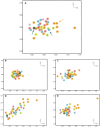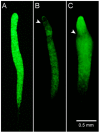ABC transporters in Dictyostelium discoideum development
- PMID: 23967067
- PMCID: PMC3743828
- DOI: 10.1371/journal.pone.0070040
ABC transporters in Dictyostelium discoideum development
Abstract
ATP-binding cassette (ABC) transporters can translocate a broad spectrum of molecules across the cell membrane including physiological cargo and toxins. ABC transporters are known for the role they play in resistance towards anticancer agents in chemotherapy of cancer patients. There are 68 ABC transporters annotated in the genome of the social amoeba Dictyostelium discoideum. We have characterized more than half of these ABC transporters through a systematic study of mutations in their genes. We have analyzed morphological and transcriptional phenotypes for these mutants during growth and development and found that most of the mutants exhibited rather subtle phenotypes. A few of the genes may share physiological functions, as reflected in their transcriptional phenotypes. Since most of the abc-transporter mutants showed subtle morphological phenotypes, we utilized these transcriptional phenotypes to identify genes that are important for development by looking for transcripts whose abundance was unperturbed in most of the mutants. We found a set of 668 genes that includes many validated D. discoideum developmental genes. We have also found that abcG6 and abcG18 may have potential roles in intercellular signaling during terminal differentiation of spores and stalks.
Conflict of interest statement
Figures




Similar articles
-
Genetic evidence that the acyl coenzyme A binding protein AcbA and the serine protease/ABC transporter TagA function together in Dictyostelium discoideum cell differentiation.Eukaryot Cell. 2006 Dec;5(12):2024-32. doi: 10.1128/EC.00287-05. Epub 2006 Oct 20. Eukaryot Cell. 2006. PMID: 17056744 Free PMC article.
-
Cheating by exploitation of developmental prestalk patterning in Dictyostelium discoideum.PLoS Genet. 2010 Feb 26;6(2):e1000854. doi: 10.1371/journal.pgen.1000854. PLoS Genet. 2010. PMID: 20195510 Free PMC article.
-
TagA, a putative serine protease/ABC transporter of Dictyostelium that is required for cell fate determination at the onset of development.Development. 2003 Jul;130(13):2953-65. doi: 10.1242/dev.00523. Development. 2003. PMID: 12756178
-
Proteomics opens doors to the mechanisms of developmentally regulated secretion.Mol Cell Proteomics. 2003 Nov;2(11):1156-63. doi: 10.1074/mcp.R300011-MCP200. Epub 2003 Sep 22. Mol Cell Proteomics. 2003. PMID: 14504294 Review.
-
Neurotransmitter receptor homologues of Dictyostelium discoideum.J Mol Neurosci. 2010 Jun;41(2):263-6. doi: 10.1007/s12031-009-9298-0. Epub 2009 Oct 13. J Mol Neurosci. 2010. PMID: 19823779 Review.
Cited by
-
Proteomic and Transcriptomic Profiling Identifies Early Developmentally Regulated Proteins in Dictyostelium Discoideum.Cells. 2019 Oct 1;8(10):1187. doi: 10.3390/cells8101187. Cells. 2019. PMID: 31581556 Free PMC article.
-
Altered N-glycosylation modulates TgrB1- and TgrC1-mediated development but not allorecognition in Dictyostelium.J Cell Sci. 2015 Nov 1;128(21):3990-6. doi: 10.1242/jcs.172882. Epub 2015 Sep 10. J Cell Sci. 2015. PMID: 26359303 Free PMC article.
-
Transport in technicolor: mapping ATP-binding cassette transporters in sea urchin embryos.Mol Reprod Dev. 2014 Sep;81(9):778-93. doi: 10.1002/mrd.22357. Epub 2014 Aug 22. Mol Reprod Dev. 2014. PMID: 25156004 Free PMC article. Review.
-
The Long Noncoding RNA Transcriptome of Dictyostelium discoideum Development.G3 (Bethesda). 2017 Feb 9;7(2):387-398. doi: 10.1534/g3.116.037150. G3 (Bethesda). 2017. PMID: 27932387 Free PMC article.
-
Leaps and lulls in the developmental transcriptome of Dictyostelium discoideum.BMC Genomics. 2015 Apr 13;16(1):294. doi: 10.1186/s12864-015-1491-7. BMC Genomics. 2015. PMID: 25887420 Free PMC article.
References
-
- Higgins CF (1992) ABC transporters: from microorganisms to man. Annu Rev Cell Biol 8: 67–113. - PubMed
-
- Dean M, Annilo T (2005) Evolution of the ATP-binding cassette (ABC) transporter superfamily in vertebrates. Annu Rev Genomics Hum Genet 6: 123–142. - PubMed
-
- ABC-Transporter Genes. Available: http://wwwdev.genenames.org/genefamily/abc.html. Accessed 2013 June 21.
-
- Hughes TR, Marton MJ, Jones AR, Roberts CJ, Stoughton R, et al. (2000) Functional discovery via a compendium of expression profiles. Cell 102: 109–126. - PubMed
Publication types
MeSH terms
Substances
Grants and funding
LinkOut - more resources
Full Text Sources
Other Literature Sources
Molecular Biology Databases

